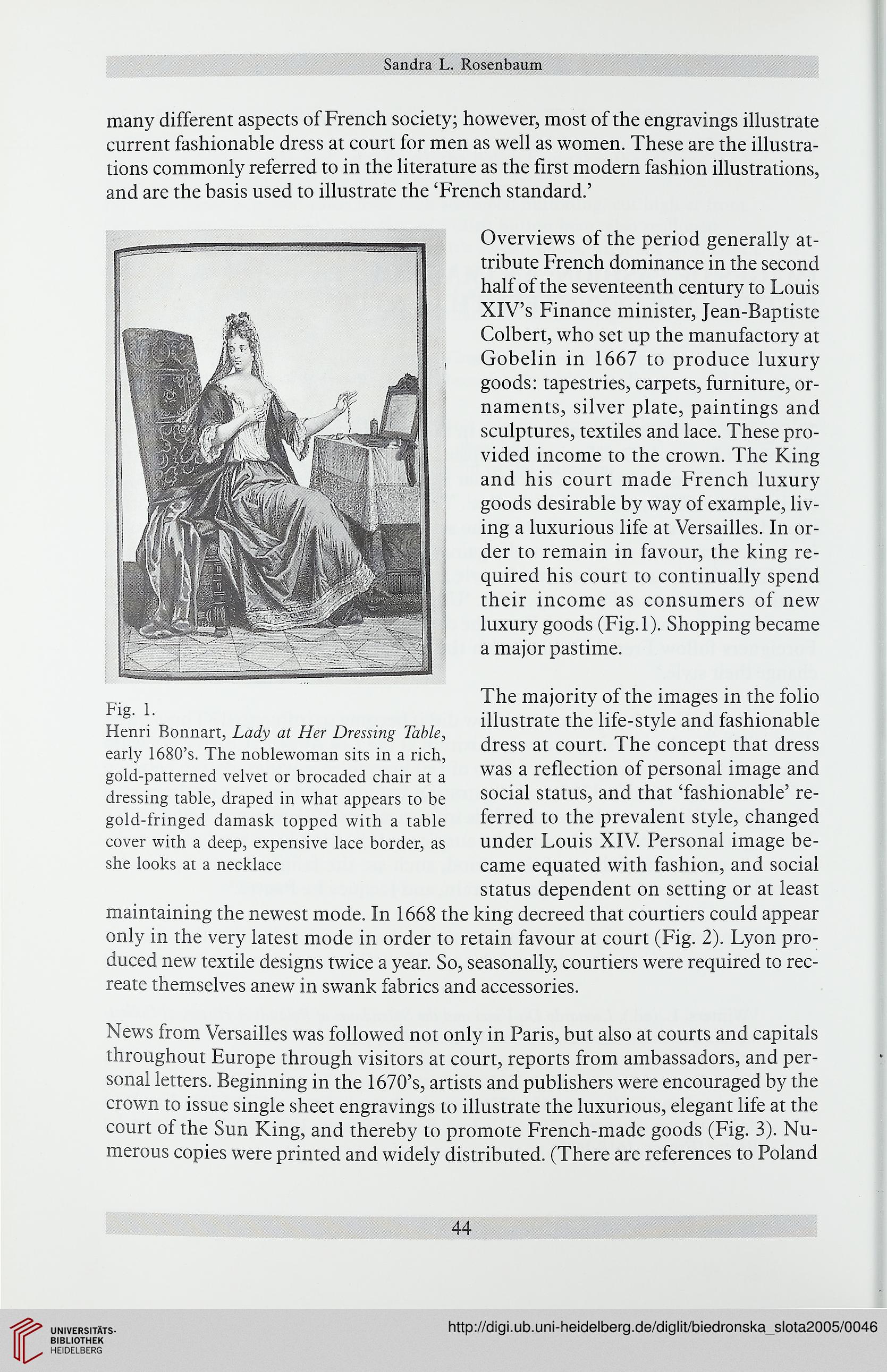Sandra L. Rosenbaum
many different aspects of French society; however, most of the engravings illustrate
current fashionable dress at court for men as well as women. These are the illustra-
tions commonly referred to in the literaturę as the first modern fashion illustrations,
and are the basis used to illustrate the 'French standard.'
Overviews of the period generally at-
tribute French dominance in the second
half of the seventeenth century to Louis
XIV's Finance minister, Jean-Baptiste
Colbert, who set up the manufactory at
Gobelin in 1667 to produce luxury
goods: tapestries, carpets, furniture, or-
naments, silver plate, paintings and
sculptures, textiles and lace. These pro-
vided income to the crown. The King
and his court made French luxury
goods desirable by way of example, liv-
ing a luxurious life at Versailles. In or-
der to remain in favour, the king re-
ąuired his court to continually spend
their income as consumers of new
luxury goods (Fig.l). Shopping became
a major pastime.
The majority of the images in the folio
illustrate the life-style and fashionable
dress at court. The concept that dress
was a reflection of personal image and
social status, and that 'fashionable' re-
ferred to the prevalent style, changed
under Louis XIV. Personal image be-
came eąuated with fashion, and social
status dependent on setting or at least
maintaining the newest mode. In 1668 the king decreed that courtiers could appear
only in the very latest mode in order to retain favour at court (Fig. 2). Lyon pro-
duced new textile designs twice a year. So, seasonally, courtiers were reąuired to rec-
reate themselves anew in swank fabrics and accessories.
News from Versailles was followed not only in Paris, but also at courts and capitals
throughout Europę through visitors at court, reports from ambassadors, and per-
sonal letters. Beginning in the 1670's, artists and publishers were encouraged by the
crown to issue single sheet engravings to illustrate the luxurious, elegant life at the
court of the Sun King, and thereby to promote French-made goods (Fig. 3). Nu-
merous copies were printed and widely distributed. (There are references to Poland
Fig. 1.
Henri Bonnart, Lady at Her Dressing Table,
early 1680's. The noblewoman sits in a rich,
gold-patterned velvet or brocaded chair at a
dressing table, draped in what appears to be
gold-fringed damask topped with a table
cover with a deep, expensive lace border, as
she looks at a necklace
44
many different aspects of French society; however, most of the engravings illustrate
current fashionable dress at court for men as well as women. These are the illustra-
tions commonly referred to in the literaturę as the first modern fashion illustrations,
and are the basis used to illustrate the 'French standard.'
Overviews of the period generally at-
tribute French dominance in the second
half of the seventeenth century to Louis
XIV's Finance minister, Jean-Baptiste
Colbert, who set up the manufactory at
Gobelin in 1667 to produce luxury
goods: tapestries, carpets, furniture, or-
naments, silver plate, paintings and
sculptures, textiles and lace. These pro-
vided income to the crown. The King
and his court made French luxury
goods desirable by way of example, liv-
ing a luxurious life at Versailles. In or-
der to remain in favour, the king re-
ąuired his court to continually spend
their income as consumers of new
luxury goods (Fig.l). Shopping became
a major pastime.
The majority of the images in the folio
illustrate the life-style and fashionable
dress at court. The concept that dress
was a reflection of personal image and
social status, and that 'fashionable' re-
ferred to the prevalent style, changed
under Louis XIV. Personal image be-
came eąuated with fashion, and social
status dependent on setting or at least
maintaining the newest mode. In 1668 the king decreed that courtiers could appear
only in the very latest mode in order to retain favour at court (Fig. 2). Lyon pro-
duced new textile designs twice a year. So, seasonally, courtiers were reąuired to rec-
reate themselves anew in swank fabrics and accessories.
News from Versailles was followed not only in Paris, but also at courts and capitals
throughout Europę through visitors at court, reports from ambassadors, and per-
sonal letters. Beginning in the 1670's, artists and publishers were encouraged by the
crown to issue single sheet engravings to illustrate the luxurious, elegant life at the
court of the Sun King, and thereby to promote French-made goods (Fig. 3). Nu-
merous copies were printed and widely distributed. (There are references to Poland
Fig. 1.
Henri Bonnart, Lady at Her Dressing Table,
early 1680's. The noblewoman sits in a rich,
gold-patterned velvet or brocaded chair at a
dressing table, draped in what appears to be
gold-fringed damask topped with a table
cover with a deep, expensive lace border, as
she looks at a necklace
44





